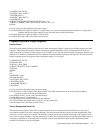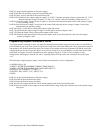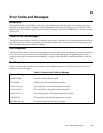
Command Summary106
Table C-l. Command Summary (continued)
Command Description
DSP? Queries the present status of the display (see page 78). Response is either a 1 (on)
or a 0 (off).
DSP " xxxxxxxxxxxx” Puts the quoted string on the power supply's front panel display (see page 79).
Only numerals, upper case letters, and spaces are allowed (12 characters max) in
the quoted string
*ERR? Queries the present programming or hardware error (see page 79). An error code
number is returned over the GP-IB to identify the error. In the local mode, pressing
the ERR key will cause the appropriate error message (not the error code) to be
displayed at the front panel. The error register is cleared after being read.
*FAULT? < ch > Queries the fault register of the specified output channel (see Mask and Fault
Register, page 74). A bit is set in the fault register when the corresponding bit in
both the status and the mask registers. The response is an integer 0 to 255. The
fault register is cleared after being read.
ID? Queries the identification (model number) of the supply. Response can be Agilent
6621A, Agilent 6622A, Agilent 6623A, Agilent 6624A, or Agilent 6627A, as
applicable (see ID Query, page 79).
IDATA < ch >, < Ilo >, < Ihi > Sends data to calibrate the current setting and readback circuits of the specified
output channel. Ilo and Ihi are measured values which the supply uses to calculate
correction constants (see Appendix A).
IHI < ch > Causes the current of the specified output channel to go to the high calibration
point (see Appendix A).
ILO <ch> Causes the current of the specified output channel to go to the low calibration point
(see Appendix A).
IOUT? < ch > Queries the measured output current of the specified output channel (see page
69). The response is a real number. The front panel display can be used to monitor
the measured output current (and voltage) of the selected output channel.
*ISET < ch >, < current > Sets the current of the specified output channel (see page 69).
*ISET? <ch> Queries the present current setting of the specified output channel (see page 69).
The response is a real number.
*OCP < ch >, < on/off > Enables the overcurrent protection circuit for the specified output channel. This
circuit, when enabled, causes the output to go to the off state when the output is in
the + CC mode. On/off is a 1 to turn on (enable) or a 0 to turn off (disable) the
circuit (see page 72).
* Indicates that the command can be executed from the front panel.


















